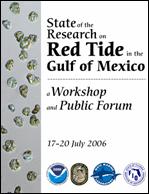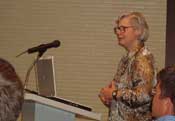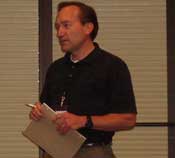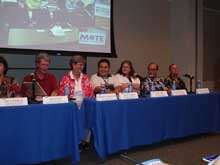You are here: Home › Stressors › Extreme Events › Harmful Algal Blooms › Feature Stories › Red Tide Workshop & Public Forum

Red Tide Workshop & Public Forum Highlight Scientific History of Red Tide, Synthesize Current Research, and Identify Future Research Needs for the Prediction, Management, Control, and Mitigation of the Florida HAB species, Karenia brevis
State of the Research on Red Tide in the Gulf of Mexico Workshop Assessed Progress of Research and Identified Future Research Needs
NOAA's National Centers for Coastal Ocean Science/Center for Sponsored Coastal Ocean Research (CSCOR) jointly sponsored a scientific workshop with Mote Marine Laboratory and the Florida Fish and Wildlife Research Institute, bringing together 75 national and international experts on Florida red tide and receiving significant press coverage. It summarized and synthesized existing research on K. brevis in the following areas: cellular and molecular biology, physiology and ecology, coastal ocean circulation, observation systems, and models; polyether brevetoxins, toxins in the food web and impacts, monitoring, mitigation, and management, prevention and control, and community effects and outreach.

Plenary speakers described how the development of new tools, such as new methods for detecting K. brevis cells and toxins and improved models, have greatly enhanced managers' ability to monitor and predict red tides and their impacts. For example the NOAA Harmful Algal Bloom (HAB) Bulletin provides managers with twice weekly forecasts of bloom occurrence and transport. K. brevis was also described as remarkably complex and adaptable for a single celled organism. Its ability to form huge blooms is only partially understood, but is key to predicting and preventing blooms. Presentations highlighted the progress that has been made in the last few years in understanding how the toxins impact human health, and a wide variety of organisms in the marine environment, leading to improved mitigation of impacts. Current shellfish monitoring is extraordinarily effective, as there have been no cases of Neurotoxic Shellfish Poisoning (NSP) due to shellfish from legally harvested areas. Efforts to control K. brevis blooms dating back to the 1950's were also described. Recent results with clay flocculation and algicidal bacteria are promising, but substantial regulatory hurdles exist that require better understanding of the environmental impact.
In ten hours of discussion, scientists identified research gaps, and formulated future research priorities. The priorities included: determining the role of all nutrient sources, especially land-based nutrients in stimulating blooms; identifying the factors causing blooms to begin, continue, and end; understanding the three dimensional movement of ocean currents that transport blooms from offshore to nearshore; developing and testing environmentally-acceptable methods of bloom control; improving monitoring and prediction; assessing the public health, socioeconomic impacts and ecosystems impacts of blooms; and developing better public education and outreach to minimize impacts.

The four day workshop, held on July 17-20, 2006, at Mote Marine Laboratory in Sarasota, Florida will generate a technical report, describing the needs for future research, and a special issue of the scientific journal, Harmful Algae, featuring articles by the plenary speakers:
- Dr. Fran VanDolah, National Oceanic & Atmospheric Administration
- Dr. Gabriel Vargo, University of South Florida
- Dr. Robert Weisberg, University of South Florida
- Dr. John Walsh, University of South Florida
- Dr Daniel Baden, University of North Carolina— Wilmington
- Dr. Jan Landsberg, Florida Fish & Wildlife Conservation Commission
- Dr. Cindy Heil, Florida Fish & Wildlife Conservation Commission
- Dr. David Heil, Florida Department of Agriculture & Consumer Services
- Dr. Mario Sengco, Smithsonian Environmental Research Center
- Dr. Lorraine Backer, Centers for Disease Control & Prevention
Public Forum Informs Community about Results of Current Florida Red Tide Research and Future Research Needs

Immediately following the workshop, a panel of scientists met with the public at a moderated forum held on July 20, 2006, at Mote Marine Laboratory's Keating Marine Education Center, and remote locations at Florida Gulf Coast University, Fort Myers and the U.S. Geological Survey's Center for Coastal and Watershed Studies, St. Petersburg. Over two hundred interested citizens gathered at three different locations in Southwest Florida to hear top red tide scientists summarize past research findings, public survey results, provide an overview of future critical research needs, and respond to questions from the public. Although the questions and comments from the audience covered a range of topics, they focused primarily on whether nutrients from land-based sources, influenced by human activities, cause or enhance K. brevis blooms, and feasibility and environmental consequences of trying to control blooms.
Public Survey
A key element of the State of the Research on Red Tide in the Gulf of Mexico Workshop and Public Forum was public involvement. In efforts to engage the public in the scientific discussion, an online survey, hosted by Mote Marine Laboratory, was designed and distributed prior to the workshop by numerous media outlets including:

- The St. Petersburg Times
- The (Bradenton) Herald
- The Sarasota Herald-Tribune
- The Charlotte Sun
- The News-Press ( Fort Myers )
Television
- ABC 7, Sarasota
- CBS 10, Tampa
- SNN 6, Sarasota
- Bay News 9, Tampa
- WINK/WNOG, Fort Myers
- ABC 7/ NBC 2, Fort Myers
Radio
- WGCU 90.1 FM, covering southern Sarasota County through northern Collier County
- WUSF 89.7 FM, covering Sarasota County to Hillsborough County
- ClearChannel Radio, Sarasota
The results of the survey were presented to workshop participants and presented at the public forum. At the time of the workshop 444 responses were received from 155 zip codes. Nearly 70% of the respondents were permanent residents of Florida. The survey requested that respondents prioritize 12 red tide research areas. The survey found that the top three were:
- Develop models to identify why blooms start, how they're maintained
and why they end,
- Determine how man-made nutrients affect the frequency, intensity
or occurrence of red tide,
- Evaluate and test different methods to control red tides without harming the environment.
NOAA Research on Karenia brevis in the Gulf of Mexico
NOAA's National Centers for Coastal Ocean Science/Center for Sponsored Coastal Ocean Research (CSCOR) has invested more than $12 million since 1997 in peer-reviewed, competitive extramural research to develop better methods of detecting and predicting blooms and finding ways to reduce or prevent impacts on humans, coastal economies, and ecosystems (click here for a list of projects) through its Monitoring and Event Response for Harmful Algal Blooms (MERHAB) program and the interagency Ecology and Oceanography of Harmful Algal Blooms (ECOHAB) program. Intramural research programs have focused on understanding the ecology of K. brevis, toxin impacts on humans and higher trophic levels, and monitoring and predicting K. brevis (click here for a list of projects).
What is Florida Red Tide?
Florida red tides occur nearly annually on Florida's west coast and in other areas of the Gulf of Mexico as well. Karenia brevis, the harmful algal bloom (HAB) species that causes red tide in the Gulf of Mexico, produces neurotoxins that can kill marine mammals, turtles, birds, and fish. Toxin-containing aerosols caused by blooms near beaches cause human respiratory problems. Finally, the toxin can accumulate in shellfish and cause Neurotoxic Shellfish Poisoning (NSP) if humans consume contaminated shellfish. States in the Gulf of Mexico have extensive shellfish monitoring programs to protect humans from NSP, but blooms are still a threat to human health, endangered species, and coastal economies.
Related Links
- CSCOR Sponsored Research Advances Efforts to Understand Recent Florida Red Tide Events
- BreveBusters Provide Automated, In-Water Detection of Florida Red Tide Conditions
- New Monitoring Capability to Improve Forecasts of Florida Harmful Algal Blooms
- Click Here For More Information on Harmful Algal Blooms (or HABs)
For more information, please contact Leigh Zimmerman at (301) 713-3338 ext. 125 or Leigh.Zimmerman@noaa.gov.

